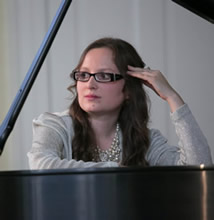As part of his residency at Duke, pianist Edmund Battersby played a solo recital on September 30, 2002 to a sparse Baldwin Auditorium audience. Battersby will also give a masterclass October 3, a lecture-demonstration on historical instruments October 4, and a chamber music recital with the Ciompi Quartet on October 5 (see the CVNC calendar for more details). Curiously, his bio lists no nationality, but, taking into account his training and some aspects of his repertoire, I’d say he’s American. Battersby is a fine pianist, with an attractive tone and a straight-forward musical approach, who makes his points through articulation and rhythmic emphasis. He’s also a member of the second string of concert pianists, like David Korevaar who played a recital at UNC CH last November. These players are a pleasure to hear but lack the final degree of ability necessary to put them among the pianistic elite.
Battersby began his intelligently programmed recital with two works by Mozart – the enigmatic Rondo in A Minor, K.511, and the volatile Sonata in A Minor, K.310, the only minor-key piano sonata in Mozart’s output. The Rondo was not a promising beginning, its contrapuntal fabric obscured by over-pedaling and a memory slip or two. The Sonata’s three movements fared better as the pianist met the considerable technical demands of the piece with style and rhythmic flexibility. Invertible counterpoint figures significantly in every movement and the performer has to execute material equally well with either hand as the music is exchanged between them. The turbulent opening movement was well-played although the tempo was a fleet allegro with none of the maestoso feeling Mozart calls for in his tempo marking. The emotional depth of the Andante came across clearly and Battersby shaped the awkward final Presto with great attention to detail, making a cogent musical statement out of a movement that can be anti-climatic.
Following the Mozart sonata with the Sonata No. 2 in G Minor, Op. 22, of Robert Schumann proved to be a provocative choice as the back-to-back hearings of the two works demonstrated just how much the two composers differed in their understanding of the sonata as a musical genre and process. The principle of interrelated duality that characterizes the thematic material of the sonata form practiced by Mozart has, in the Schumann, become a wildly disparate thing built out of irreconcilable contrasts between the character of thematic groups. Battersby successfully handled the challenges of the explosive first movement, with its deliberately impossible tempo markings, and made sense out of its potentially confusing structure by shaping the main themes and transitions with surety. The Andantino movement was played with a confident sense of line and harmonic tension while the lightning quick, yet frighteningly brief Scherzo sounded as unsettling as Schumann must have intended. In the concluding Rondo, Battersby went all out technically in order to accommodate the obsessive rhythms and desolate musical rhetoric of a piece with none of the customary breeziness usually associated with the rondo form.
For the second half, Battersby chose works by Frédéric Chopin in almost every genre in which he wrote. He began with two Nocturnes, Op. 9/3, in B, and Op. 62/2, in E. These works benefited from Battersby’s unsentimental, muscular approach as the melodies, harmonic motion and the contrapuntal bedrock of the bass lines stood out clearly, but the playing lacked an equal dose of subtlety most notable in the louder than necessary dynamic levels. Next came the Impromptu in A-Flat, Op. 29, a lovely work that the pianist tossed off as if it were an improvisation, handling the contrast between the outer section and the minor key middle section with finesse rather than bluster.
An unknown (to me) composition and the Mazurka in A Minor, Op. 67/4, followed, their brief but charming appearances leading to the most serious set of the evening, a grouping of three Etudes (Op. 10/6, in E-Flat Minor, Op. 25/11, in A Minor, and Op 25/10, in B Minor). These exercises in pianistic sadism have remained touchstones for technical and interpretive achievement and Battersby responded with his most sustained performances of the night. In Op. 10/6, a work often played too slowly, his over-emphasis of the chromatic countermelody that presents the piece’s chief difficulty obscured the lovely main melody and diverted attention from the startling harmonies. He handled the A Minor etude’s brutal sextuplet figures with their accompanying counter melodies and end-to-end arpeggio and scale runs with aplomb and made a miniature tone poem out of the ceaseless octaves of the B Minor etude. The reflective middle section of the octave etude was played to the hilt, and the acceleration back to the turmoil of the outer section sounded inevitable and unforced.
All in all, Battersby’s recital was thoughtfully programmed but unevenly played. His musical insights outweighed the occasional miscalculations, and I would recommend going to hear his demonstration of historical instruments on October 4 and the chamber music recital with the Ciompi on October 5. More information on the performer can be found at http://www.edmundbattersby.com/ [inactive 10/03], and his most easily accessible recordings are two volumes of music for violin and piano by Dvorák, on the Naxos label.












